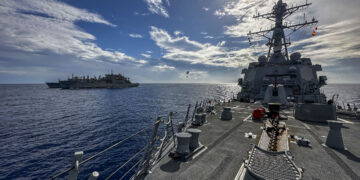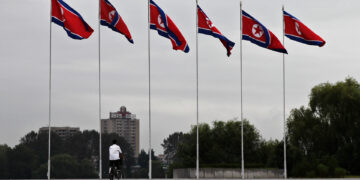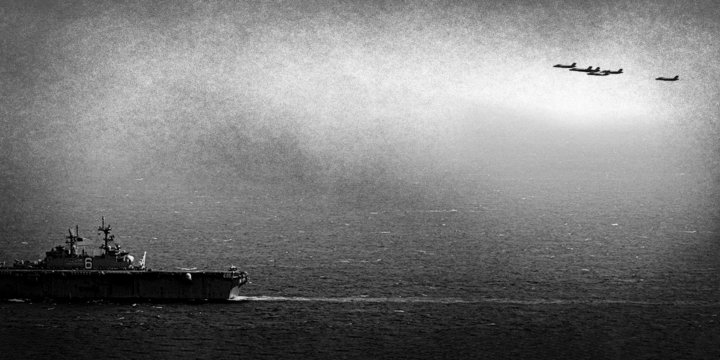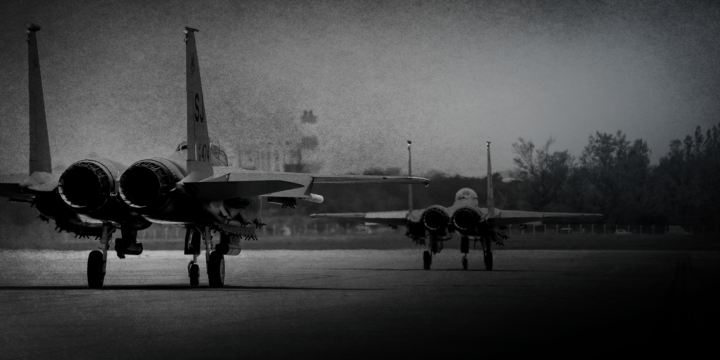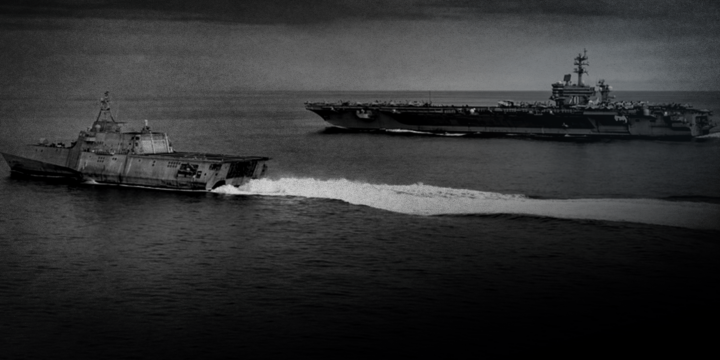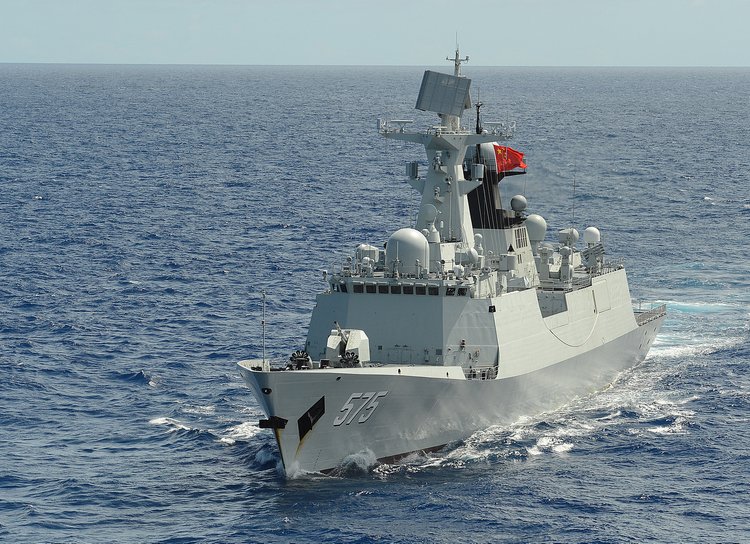
Key points
- The military value of Taiwan to China should be viewed in the aggregate. There are detriments that could come with seizing the island in addition to advantages for China’s military position.
- Taiwan is likely to be of greater utility to China in consolidating its hold over the East and South China Seas, as opposed to projecting power deep into the Pacific Ocean.
- Basing sensors on Taiwan would enhance the effective range of China’s anti-access and area denial (A2/AD) capabilities against mobile targets, like U.S. aircraft carriers.
- The technical deficiencies of Chinese nuclear submarines will limit the advantages of occupying Taiwan in terms of undersea warfare, but there could be gains with respect to operation of China’s conventionally powered submarines.
- Depending on the depth of resistance China encounters, force requirements for permanently garrisoning Taiwan could place major stress on Chinese military and security forces.
Amid the debate over the U.S. policy of strategic ambiguity, Taiwan’s military relevance is usually consigned to a predetermined supporting role. Advocates for defending Taiwan tend to ascribe it significant military value while proponents of an outright abrogation of any U.S. defense commitment to Taiwan often downplay its utility.1See, for example, Charles L. Glaser, “Washington Is Avoiding the Tough Questions on Taiwan and China,” Foreign Affairs, April 28, 2021, https://www.foreignaffairs.com/articles/asia/2021-04-28/washington-avoiding-tough-questions-taiwan-and-china, and Blake Herzinger, “Abandoning Taiwan Makes Zero Moral or Strategic Sense,” Foreign Policy, May 3, 2021, https://foreignpolicy.com/2021/05/03/taiwan-policy-us-china-abandon/. Seldom is the question of military utility looked at discretely, in the absence of policy implications.2For another effort in this vein, see Brendan Rittenhouse Green and Caitlin Talmadge, “Then What? Assessing the Strategic Military Implications of Chinese Control of Taiwan,” Defense Threat Reduction Agency, May 2021.
This paper is an attempt to do so. It proceeds in three parts. First, Taiwan’s characteristics and history are reviewed to inform a discussion of the island’s value as a stepping stone to additional territorial conquests in the Pacific. Second, the operational advantages of Chinese occupation of Taiwan are examined with respect to three specific capabilities: anti-access and area denial (A2/AD), sea control, and undersea warfare. Finally, the potential military costs of Chinese occupation are addressed.
Characteristics and history
Perhaps the first essential point to convey is that while Taiwan is commonly referred to as “an island,” it is actually an archipelago of more than 60 constituent bodies. Many of these are divided into sub-archipelagos focused around some of the larger minor islands. The most prominent are Matsu, Kinmen (previously Quemoy), and Penghu. Matsu and Kinmen hug the Chinese coast, in Kinmen’s case sitting fewer than five miles off the mainland. Penghu lies farther across the Taiwan Strait and is renowned for the excellent natural harbor at its capital, Magong.3For an extended discussion of the geographic features and strategic importance of Matsu, Kinmen, and Penghu, see Ian Easton, The Chinese Invasion Threat (Manchester, UK: Eastbridge Books, 2019), 97–103. The main island of Taiwan is by far the largest body in the archipelago at just under 14,000 square miles. It sits approximately 100 miles off the Chinese coast, a similar distance to that crossed by the Allies in the D-Day invasion of occupied France.4This is not to imply that a Chinese invasion of Taiwan would play out in similar fashion to Operation Overlord. Congruence in the distance across the English Channel and the Taiwan Strait is largely where the comparison ends. See Ian Easton, “Why a Taiwan Invasion Would Look Nothing Like D-Day,” The Diplomat, May 26, 2021, https://thediplomat.com/2021/05/why-a-taiwan-invasion-would-look-nothing-like-d-day/.
It is hard to avoid historical precedents when discussing Taiwan’s military value. One analytic metaphor holds that the island is “the Asia Fulda Gap,” a reference to the lowlands of East Germany once considered a prime invasion route for Warsaw Pact forces during the Cold War.5See, for example, the comments by Randall Schriver in Helen Davidson, “Chinese Flyovers Towards Taiwan Peaked in October amid Rising Tensions,” The Guardian, November 2, 2020, https://www.theguardian.com/world/2020/nov/02/chinese-flyovers-towards-taiwan-peaked-in-october-amid-rising-tensions. Others point to the fact that Formosa (as Taiwan was then known) figured prominently in alternate U.S. plans for the invasion of Japan during World War II.6See, for example, Thomas Shugart’s Twitter post as referenced in Herzinger, “Abandoning Taiwan Makes Zero Moral or Strategic Sense.” Both analogies conjure the impression of Taiwan as a springboard for a more ambitious Chinese campaign of expansion throughout the Pacific.
Taiwan and its environs
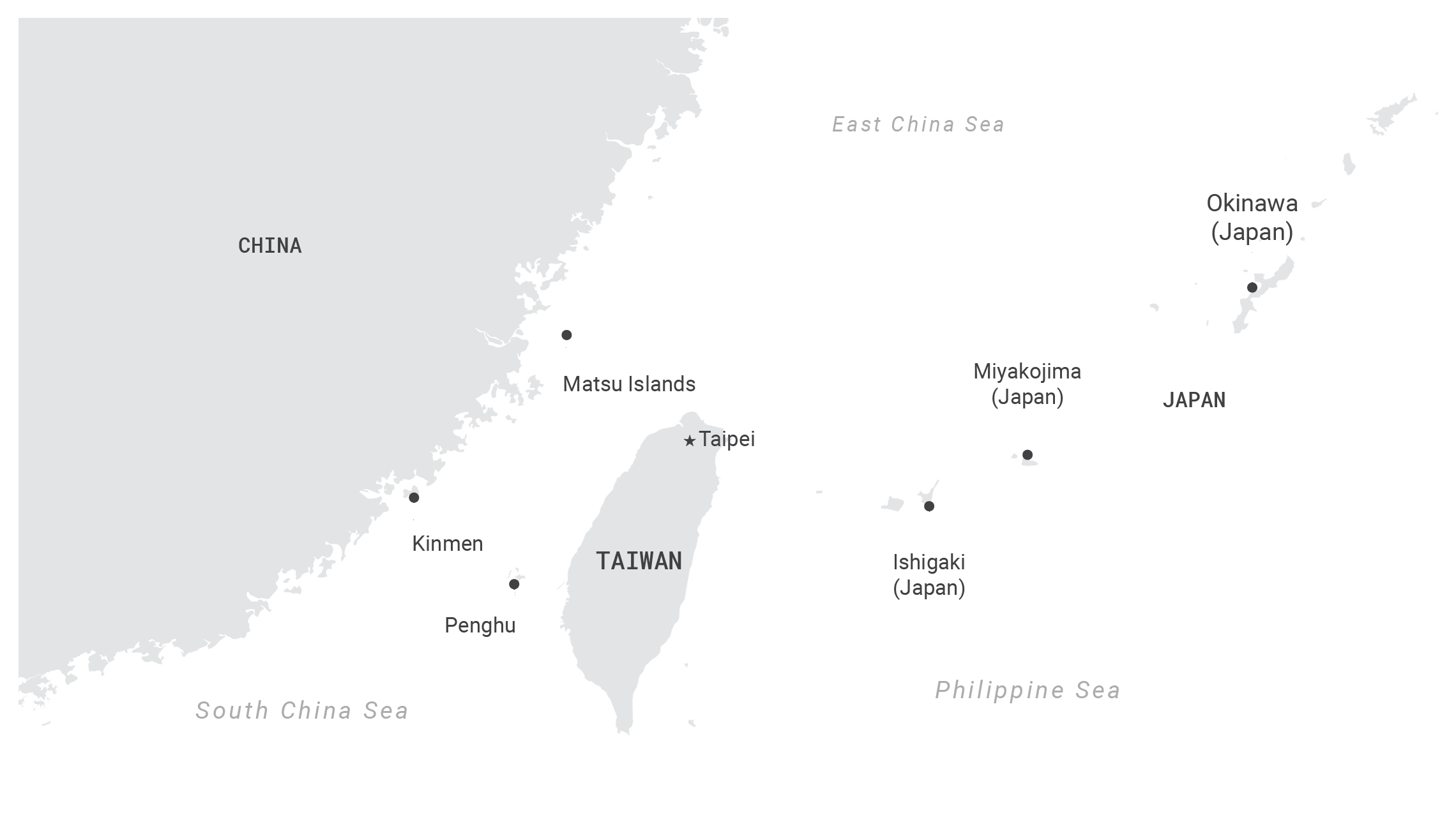
Formosa vs. Luzon
But these comparisons should be carefully interrogated, not least because they speak to the essential question of Taiwan’s fitness as a conduit for further conquest. For example, it is true that throughout the Pacific War there was an active debate among senior U.S. military planners over what should be the penultimate goal before Japan itself—Formosa or Luzon, the northernmost island in the Philippines. Roughly speaking, proponents of Luzon consisted of the commanders in the Pacific (most prominently Gen. Douglas MacArthur) while those arguing for Formosa were led by planners in Washington (notably the Chief of Naval Operations, Adm. Ernest King).7For a more fulsome discussion of the debate among U.S. military commanders over “Formosa vs. Luzon,” see Robert Ross Smith, Triumph in the Philippines (1993; repr., Washington, DC: United States Army, 1963), 3–17.
What is significant here is that Formosa itself was never envisioned as a staging area for invading Japan, but rather for projecting additional U.S. military power into the Chinese mainland. This strategy called for the invasion of Japan to be conducted with the support of new U.S. air bases on the Chinese coast.8Smith, Triumph in the Philippines, 3–4. Formosa’s role was largely secondary, supporting supply lines into China, not as an actual stepping stone northward.
The plan never came to fruition in part because the force commitments and potential casualties were deemed prohibitive, a salient commentary on the challenge Taiwan poses to any invader.9Smith, Triumph in the Philippines, 11–13. But this example illustrates an important point about Taiwan’s strategic orientation: It is best viewed along an east-west axis rather than a north-south one. Taiwan’s primary relevance is as a corridor for the flow of force into and out of China itself. Having Taiwan in friendly hands makes it easier for the United States to strike landward just as Chinese occupation of the main island would significantly complicate such operations.
The stopping power of water
Another example from World War II is instructive. Now all but forgotten, some Japanese military planners once weighed a different invasion—of Hawaii. Rather than simply striking U.S. military assets at Pearl Harbor, an invasion force would seize the base outright. Plans were drawn up to dispatch a 30,000-man landing force to Oahu. The option encountered resistance from senior leaders and was discarded in the face of contending demands for Japanese manpower in Asia.10Angelo N. Caravaggio, “Winning’ the Pacific War: The Masterful Strategy of Commander Minoru Genda,” Naval War College Review 67, no. 1 (Winter 2014): 85–118.
That it was given any credence at all is indicative of the different era in which “island hopping” took place. Only in a time without long-range radar, undersea surveillance sensors, satellite reconnaissance, or even smartphones could a surprise invasion across 4,000 miles of open ocean be contemplated. Today, all of these assets could be brought to bear to identify the transport fleet a few miles out of port; sinking it could be accomplished through any number of means.
Luzon and its environs
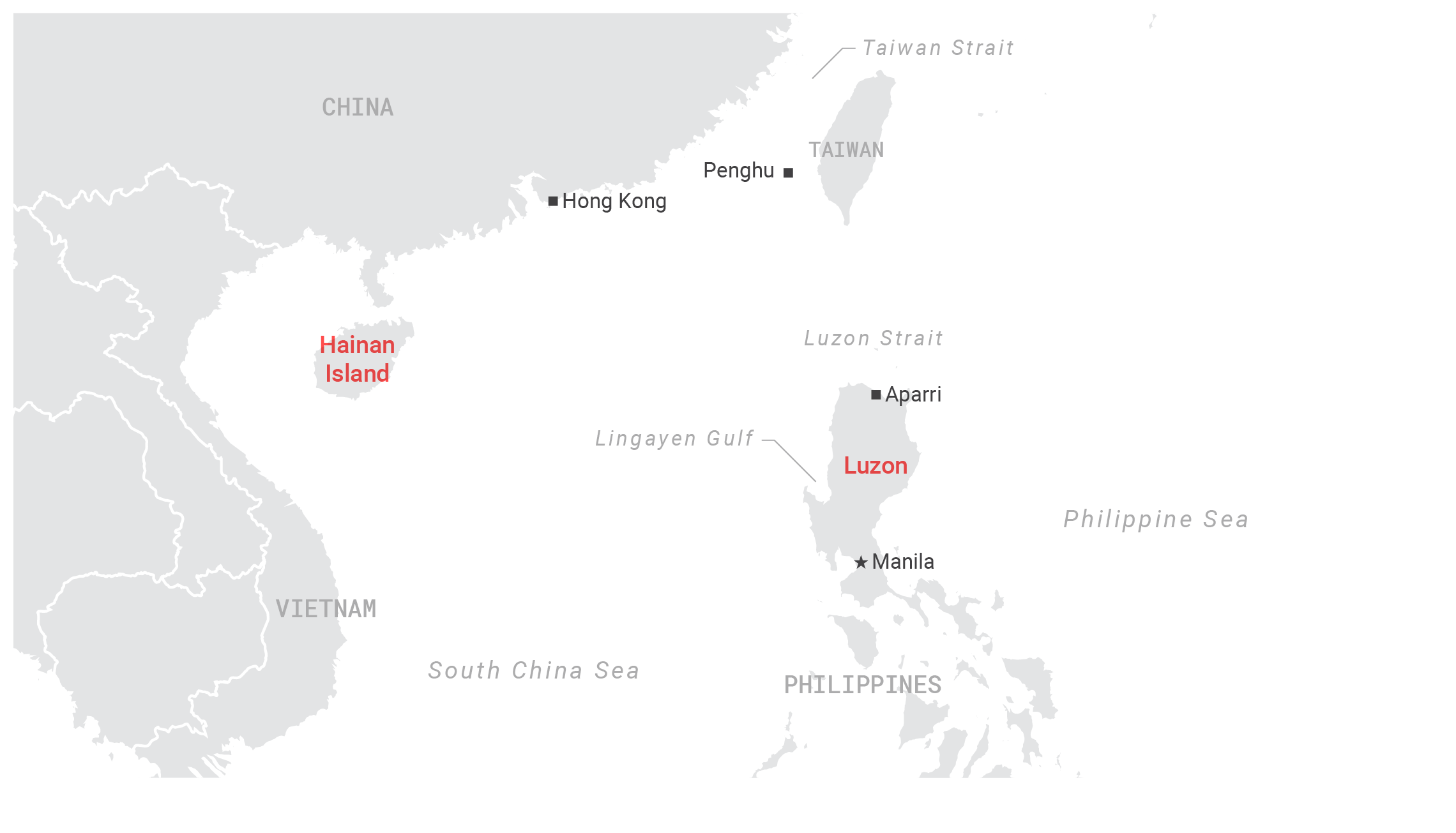
This points to a second important difference: Cruise missiles were in their infancy during World War II, their use confined to terror attacks against civilian targets, as in the case of the German V-1.11Kenneth P. Werrell, The Evolution of the Cruise Missile, (Maxwell AFB, AL: Air University Press, 1985), 41–78. In the intervening decades, these weapons have substantially increased in range, lethality, and accuracy. They first saw use in naval combat during the 1967 Arab-Israeli War, but it was the Falklands conflict that demonstrated their ability to allow a weaker maritime power to inflict substantial costs on a superior navy.12Toshi Yoshihara and James R. Holmes, Red Star Over the Pacific (Annapolis, MD: Naval Institute Press, 2018), 221–227. Today, anti-ship cruise missiles constitute the primary threat to surface vessels, significantly reducing the distance transports and landing vessels can safely transit under combat conditions.13In part, this is one reason Taiwan itself has been encouraged to invest in shore-based anti-ship cruise missiles as part of a broader asymmetric defensive strategy, a path Taipei has been reluctant to pursue. See Michael A. Hunzeker, “Taiwan’s Defense Plans Are Going Off the Rails,” War on the Rocks, November 18, 2021, https://warontherocks.com/2021/11/taiwans-defense-plans-are-going-off-the-rails/.
Crossing water has always been an extraordinarily difficult thing for armies to do; current technologies render it even more so.14For a historical overview of “the stopping power of water,” see John J. Mearsheimer, The Tragedy of Great Power Politics, updated ed. (New York: W.W. Norton & Company, 2014), 114–128. See also the discussion of the challenges of amphibious invasion in Elbridge Colby, The Strategy of Denial: American Defense in an Age of Great Power Conflict (New Haven, CT: Yale University Press, 2021), 155–159. China’s own A2/AD capabilities are testament to this. If occupying Taiwan positioned Chinese forces within, say, 10 or 20 miles of other strategic islands, like Okinawa or Luzon, the operational implications would clearly be beneficial. But that is simply not the case.
Island hopping in modern times
The factor that makes Taiwan so vulnerable to Chinese invasion is thus the same one that limits its utility for additional conquests: its proximity to the Chinese coast. Taking Taiwan only “buys” Beijing an additional 100 miles of range. As will be discussed below, in some areas—such as sensors—that translates into significant gains. And there are other undeniable benefits to China controlling the main island. But power projection elsewhere in the Pacific remains compromised by the inherent challenge of crossing water and the distance to other possible objectives. In some cases, Taiwan is not even substantially closer to potential targets than the mainland itself. For example, Okinawa is about 385 miles from Taipei but also just 450 miles from Ningbo, the headquarters of China’s East Sea Fleet.
The gains are more appreciable with respect to Luzon. It lies approximately 235 miles to Taiwan’s south as compared with 425 miles from the Chinese coast. While this almost halves the distance, Chinese forces would still need to transit more than twice the expanse required to seize Taiwan itself. And the distance is even farther if the objective is Lingayen Gulf, which both Japanese and American forces used as the main invasion point for Luzon during World War II.15Smith, Triumph in the Philippines, 18–19. The gulf is more than 400 miles from Taiwan and more than 600 miles from the Chinese coast. While there are suitable landing sites on Luzon’s northern coast—notably at Aparri—these are cut off from the south of the island (and Manila) by difficult terrain.16Northern Luzon is dominated by mountains—the Cordillera range in the west and the Sierra Madre in the east. In between lies the close confines of the Cagayan Valley, which narrows as it proceeds south. The valley’s southern end, in turn, is blocked by a third range, the Caraballo Mountains.
In the specific case of Okinawa, reasonable analysts have posited a “mini” island-hopping campaign in which China takes Taiwan then seizes the Japanese island of Ishigaki 140 miles to the northeast. This would be followed by the capture of Miyakojima 70 miles to the north, which, in turn, would serve as a jumping off point for invading Okinawa itself an additional 150 miles away.17Thomas Shugart (@tshugart3), Twitter post, April 30, 2021, https://twitter.com/tshugart3/status/1388214889424982019. In theory, this is possible. But is that sequence of maneuvers any more likely than striking across 450 miles of open ocean from Ningbo? Are three precarious amphibious operations preferable to one?
Neither approach appears inviting under conditions of modern naval warfare. Given that crossing the Taiwan Strait is already considered a risky endeavor, it is hard to be sanguine about successful amphibious operations more than twice that distance or even three or four times it. At a minimum, China would need to vastly improve its anti-submarine warfare (ASW) skills, a weakness publicly highlighted by the U.S. Department of Defense (DoD).18Office of the Secretary of Defense, “Annual Report to Congress: Military and Security Developments Involving the People’s Republic of China” (Washington, DC: Government Printing Office, 2021), 49–50, https://www.defense.gov/News/Releases/Release/Article/2831819/dod-releases-2021-report-on-military-and-security-developments-involving-the-pe/. There also are a range of anti-ship systems the Japanese—and their U.S. treaty allies—could bring to bear against naval combatants and transports slowly moving across large stretches of open water.
Another problem: Any island taken by China as a base could itself be subject to bombardment. There remains an intense debate about whether the United States would conduct conventional military strikes against mainland targets in a conflict with China.19For an in-depth discussion of this topic, see John Speed Meyers, Mainland Strikes and U.S. Military Strategy Towards China: Historical Cases, Interviews, and a Scenario-Based Survey of American National Security Elites (Santa Monica, CA: RAND Corporation, 2019), https://www.rand.org/pubs/rgs_dissertations/RGSD430.html. No such sanctuary can be expected for occupied Taiwan or other territories China seizes by force. This would compromise the suitability of any occupied island as a secure staging area for additional attacks.
All of this argues for reconsidering the aforementioned historical analogies. The Fulda Gap was dynamic terrain, with features conducive to the rapid movement of tanks. Taiwan is best thought of as static. As discussed in more detail below, subjugation of the island would be neither quick nor easy. It is far more likely to tie down significant Chinese forces than to serve as a ready conduit for additional amphibious operations. This does not entirely preclude China from one day threatening other territories in the First Island Chain. But it does argue against scenarios where Taiwan is the first move in a rapid maritime blitzkrieg.
Seeing into the Pacific
If analogies from Europe are required, Kaliningrad might be a better model than the Fulda Gap for thinking about a Chinese-occupied Taiwan—a forward sentinel bristling with anti-access systems. There would be undeniable operational advantages to Taiwan as a base for Chinese military assets. Prime among these would be China’s ability to extend the effectiveness of its A2/AD systems against mobile targets at sea, like aircraft carriers.
To date, the main weakness of A2/AD is not the weapons but the sensors that direct them. China has developed an extraordinarily capable missile arsenal. This includes anti-ship variants of its DF-21 short-range ballistic missile and its DF-26 intermediate-range ballistic missile. But these missiles are dependent on other assets to inform their targeting.
In the case of fixed targets, like U.S. bases in Japan and Guam, this is much less of an issue than it is with moving ships. China’s A2/AD capability is rightly a source of concern, but its application in practice remains uncertain when it comes to naval vessels. The key challenge is the ability to identify mobile targets at sea in real time and pass that information on immediately to missile-firing crews.20A test in August of 2020 appeared to demonstrate China’s ability to strike a moving ship in the South China Sea, with both a DF-21 and a DF-26 reportedly hitting an underway vessel in rapid succession. The test likely assuaged any lingering doubts regarding the DF-26’s accuracy, but it did not necessarily validate the ability of Chinese sensors to detect and cue missile systems because the parameters of the test are unknown (i.e., whether the ship’s position and heading were identified beforehand or if it was independently detected by cuing sensors). See Steve Stashwick, “Chinese Ballistic Missiles Fired Into South China Sea Claimed to Hit Target Ship,” The Diplomat, November 17, 2020, https://thediplomat.com/2020/11/chinese-ballistic-missiles-fired-into-south-china-sea-claimed-to-hit-target-ship/; and Joseph Trevithick, “Chinese Long-Range Ballistic Missiles Struck Moving Ship In South China Sea: Report,” The Drive, November 16, 2020, https://www.thedrive.com/the-war-zone/37662/chinese-long-range-ballistic-missiles-struck-moving-ship-in-south-china-sea-report.
Current options for maritime surveillance
China currently has four options available for maritime surveillance. The first is over-the-horizon (OTH) backscatter radars. These are large, fixed installations that can identify objects at great distances. China has two OTH radars—based in Inner Mongolia and Hubei Province—focused southeasterly, toward Taiwan and beyond.21Hans M. Kristensen, “China’s Strategic Systems and Programs” in James M. Smith and Paul J. Bolt, eds., China’s Strategic Arsenal: Worldview, Doctrine, and Systems (Washington, DC: Georgetown University Press, 2021), 116. However, OTH systems sacrifice resolution for range.22Felix K. Chang, “China’s Maritime Intelligence, Surveillance, and Reconnaissance Capability in the South China Sea,” Foreign Policy Research Institute, May 5, 2021, https://www.fpri.org/article/2021/05/chinas-maritime-intelligence-surveillance-and-reconnaissance-capability-in-the-south-china-sea/. Although one might be able to spot a carrier well into the Pacific, it would not have sufficient fidelity to provide useful targeting data.
China’s Yaogan satellite constellation provides another possibility. The Yaogans are thought to fly in groups of three with each member of the trio possessing a different sensing capability: optical, electronic intelligence, and synthetic aperture radar.23Kristensen, “China’s Strategic Systems and Programs,” 117; and Andrew Jones, “China Launches Trio of Yaogan-31 Ocean Reconnaissance Satellites,” Space News, February 24, 2021, https://spacenews.com/china-launches-trio-of-yaogan-31-ocean-reconnaissance-satellites/. Theoretically, these could provide targeting data, but whether it could be relayed in real-time to missile crews is highly uncertain.24For example, one close study of the issue suggests that the Yaogan constellation could provide the location of a U.S. aircraft carrier in the Pacific to within less than 10 km. This is an impressive technological feat and consistent with the claim that China can reliably track U.S. battlegroups in the Pacific. However, 10 km still represents too wide a variance for accurate targeting of missiles fired from hundreds, if not thousands, of miles away. See S. Chandrashekar and Soma Perumal, “China’s Constellation of Yaogan Satellites & the Anti-Ship Ballistic Missile: May 2016 Update,” International Strategic and Security Studies Programme, National Institute of Advanced Studies, May 2016, http://isssp.in/wp-content/uploads/2016/05/Yaogan-and-ASBM-May-2016-Report.pdf. Gaps in coverage are another concern, even as China continues to deploy more satellites.25Andrew Jones, “China Launches New Group of Classified Yaogan-30 Satellites,” Space News, June 18, 2021, https://spacenews.com/china-launches-new-group-of-classified-yaogan-30-satellites/.
That leaves ground- and air-based radars based in China as the main source of targeting data. But these systems are constrained by the physical limits imposed by the curvature of the earth.26For an extended discussion of the sensor limitations of Chinese A2/AD, see Steven Biddle and Ivan Oelrich, “Future Warfare in the Western Pacific,” International Security 41, no. 1 (Spring 2016): 7–48. Unlike OTH systems, they cannot see beyond the horizon. This caps their effective range at an estimated 400 kilometers (roughly a 250-mile maximum) in the case of air-based radars, which operate from much higher altitudes (and thus greater distance to the natural horizon) than their ground-based counterparts.27Biddle and Oelrich speculate that this limit could be extended to about 600 km total from the Chinese shoreline, if the aircraft were to operate off the coast but still within the protective bubble of Chinese air defenses. This could push the effective radar coverage to approximately 370 miles into the adjoining sea. See Biddle and Oelrich, “Future Warfare in the Western Pacific,” 13. However, for the moment, China only has a limited number of air-based radar platforms, consisting of its small fleet of KJ-200, KJ-2000, and newer KJ-500 airborne early warning and control (AEW&C) aircraft.28“Chapter Six: Asia,” The Military Balance, February 24, 2021, 218–313, https://doi.org/10.1080/04597222.2021.1868795. These platforms would also be highly vulnerable in a warfighting situation, which is why it is assumed here that the AEW&C aircraft would only operate from the relative safety of China’s own airspace.
Ground-based radars along the Chinese coast thus form the backbone of the current A2/AD system, at least with respect to the targeting of ships. However, their range is limited, perhaps only 200 to 250 kilometers, or a maximum of about 155 miles.29Chang, “China’s Maritime Intelligence, Surveillance, and Reconnaissance Capability in the South China Sea.” This is one reason for caution about the capability of Chinese A2/AD against surface vessels—at least as currently configured. The most reliable sensors—ground-based coastal radars—barely cover the Asian littoral seas.
Taiwan as China’s citadel
Here, Chinese occupation of Taiwan would offer significant advantages. First, the ability to base ground- and air-based radars 100 miles forward from the mainland would constitute a significant increase in overall coverage. The addition of an extra 100 miles would extend the aggregate range from China’s coast to about 255 miles in the case of ground-based systems and 350 miles for an air-based radar operating from Taiwanese airspace. Second, China could also leverage Taiwan’s Chungyang Mountains to its advantage. Ground-based radars situated in the Taiwanese mountains would gain additional range at altitude.
Overall, the zone in which Chinese sensors could target surface vessels would be substantially extended. Reliable targeting of ships to the east of Taiwan, at the far western reaches of the Philippine Sea, could be possible. Coupled with the emplacement of advanced air defenses on the main island, this would reinforce Taiwan’s status as a citadel blocking any offensive thrust toward the Chinese coast. The current situation where Taiwan instead serves as an obstacle to outward Chinese power projection would be transposed.30For a discussion of the impediments posed to Chinese air forces by Taiwan’s existing air defenses, see Green and Talmadge, “Then What? Assessing the Strategic Military Implications of Chinese Control of Taiwan,” 6–8. As much as any development, this reversal would constitute the primary military benefit to Chinese occupation of Taiwan.
The cork in the bottle
A close second is the commanding position Taiwan would give China over movement through the Asian littoral seas. Returning to U.S. planning during World War II, a secondary motivation for considering occupation of Formosa was to cut Japanese supply lines to its occupied territories in Southeast Asia and Oceania.31Smith, Triumph in the Philippines, 3–4. Adm. King famously called Taiwan “the cork in the bottle” of the South China Sea, an aphorism that remains salient today.32James R. Holmes, “Strategic Features of the South China Sea: A Tough Neighborhood for Hegemons,” Naval War College Review 67, no. 2 (Spring 2014): 47.
Closing the South China Sea?
Scenarios for closing the South China Sea have long been a concern. In particular, a blockade is seen as one potential measure for China to achieve reunification with Taiwan short of direct invasion.33Michael A. Hunzeker and Alexander Lanoszka, with Brian Davis, Matthew Fay, Erik Goepner, Joseph Petrucelli, and Erica Seng-White, A Question of Time: Enhancing Taiwan’s Conventional Deterrence Posture (Arlington, VA: Center for Security Policy Studies, 2018), 52–53, https://csps.gmu.edu/wp-content/uploads/2018/11/A-Question-of-Time.pdf. But a blockade could also be employed as a weapon against U.S. allies like Japan and South Korea, conceivably to punish either for supporting U.S. military operations or even to deter such cooperation.34In 2016, 47 percent of South Korea’s total trade passed through the South China Sea as compared to 19 percent for Japan. “Putting a Price on the South China Sea: Percentage of All Trade,” in “How Much Trade Transits the South China Sea?” Center for Strategic and International Studies, China Power, accessed February 11, 2022, https://chinapower.csis.org/much-trade-transits-south-china-sea/. Occupying Taiwan would significantly enhance China’s ability to do so.
Major straits in the western Pacific
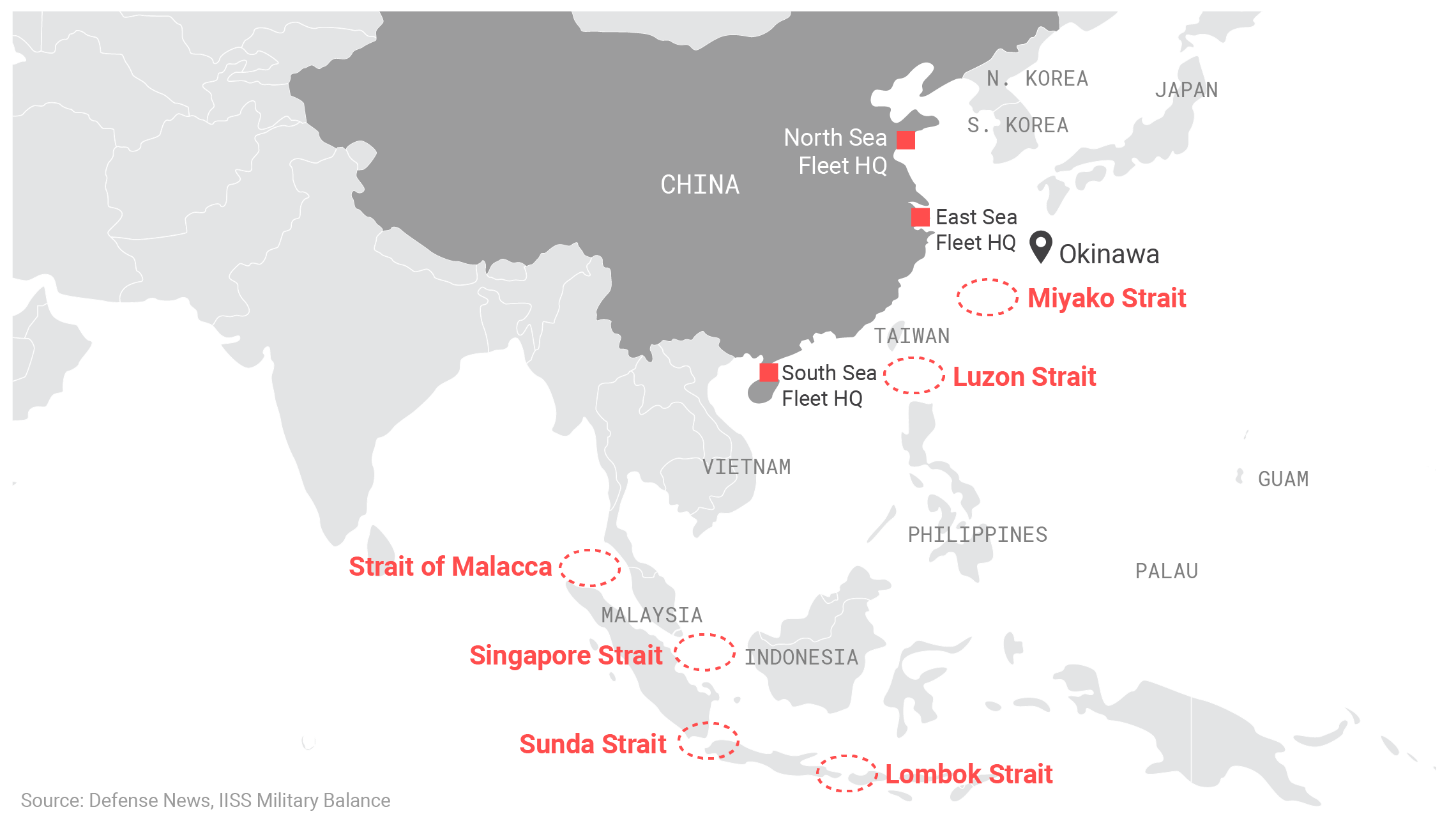
Blockades are notoriously resource-intensive endeavors.35For example, the brief, six-day “quarantine” of Cuba during the 1962 missile crisis required 46 ships, 240 aircraft, and 30,000 personnel to implement. Dan E. Caldwell, “A Research Note on the Quarantine of Cuba October 1962,” International Studies Quarterly 22, no. 4 (December 1978): 629. Effecting one in the South China Sea could consume a significant portion of the People’s Liberation Army Navy (PLAN) under current circumstances. A 2020 analysis of a reverse scenario—in which the U.S. attempted an anti-Chinese blockade of the southern approaches to the South China Sea—suggested that the U.S. Navy might not have sufficient force structure to execute the task.36Fiona S. Cunningham, “The Maritime Rung on the Escalation Ladder: Naval Blockades in a U.S.-China Conflict,” Security Studies 29, no. 4 (2020): 730–768, https://doi.org/10.1080/09636412.2020.1811462. Different options were examined, but the most taxing required 62 ships plus supporting maritime aircraft. Given its other global responsibilities and the requirement to rest and rotate forces, it was deemed unlikely the U.S. Navy could meet this commitment at its current force level.37Cunningham, “The Maritime Rung on the Escalation Ladder,” 758–760.
China’s navy is now larger than its U.S. counterpart and PLAN forces would be operating much closer to their home waters.38China has a fleet of approximately 350 battle force ships as compared to 293 for the U.S. Navy. Ronald O’Rourke, China Naval Modernization: Implications for U.S. Navy Capabilities—Background and Issues for Congress, Congressional Research Service (RL33153), updated October 28, 2021, 28–31, https://sgp.fas.org/crs/row/RL33153.pdf. These factors might allow the PLAN to enact a blockade where the U.S. Navy could not. Still, it would be an extremely taxing endeavor to maintain constant vigilance over southern chokepoints like the Malacca, Sunda, and Lombok Straits, particularly if the blockade needed to remain in effect for several months or even years. Significantly, the U.S. Navy would be better positioned to challenge such a blockade, at the fringe of China’s A2/AD bubble and outside the range of most Chinese land-based aircraft.
An occupied Taiwan could simplify matters for China if the goal were a targeted blockade against either South Korea or Japan. In that instance, it would be easier for China to concentrate on closing only the Taiwan and Luzon Straits at the north end of the South China Sea. This would be abetted by Chinese control of the Matsu, Kinmen, and Penghu archipelagoes that straddle the Taiwan Strait. PLAN forces would need to cover a smaller geographic area, as compared with the more distant and dispersed southern egress routes to the South China Sea. Under this scenario, Chinese ships would also operate in even closer proximity to their home ports and with maximum support from air assets based on the mainland. A2/AD systems and sensors placed on the main island of Taiwan itself would further facilitate the blockade and, most important, pose a major challenge to U.S. and allied navies attempting to break the cordon.
Blockade efficacy
All of that said, there are questions about the long-term efficacy of a blockade. A quantitative analysis conducted for the National Bureau of Economic Research in 2020 showed there would be detrimental impacts from a complete closure of the South China Sea for most of the top 50 economies in the world.39Kerem Coşar and Benjamin D. Thomas, “The Geopolitics of Trade in Southeast Asia,” NBER Working Paper 28048, National Bureau of Economic Research, November 2020, https://www.nber.org/papers/w28048. However, while several U.S. allies—including Australia, Japan, and South Korea—suffered negative economic effects in the simulation, none were nearly as devastated as countries like Singapore and Vietnam, which lie entirely within the confines of the South China Sea.40“Table 2: Predicted Welfare Losses for Countries in the Region,” in Coşar and Thomas, “The Geopolitics of Trade in Southeast Asia,” 11.
Most countries could adopt alternate trade patterns if pressed to do so.41Eugene Gholz and Daryl Pressman, “Protecting ‘The Prize’: Oil and U.S. National Interest,” Security Studies 19, no. 3 (2010): 462–463, https://doi.org/10.1080/09636412.2010.505865. It is worth remembering that the global economy has survived other major disruptions to maritime trade and still continued to function. For example, the Suez Canal was closed for more than seven years due to the 1967 and 1973 Arab-Israeli Wars, forcing sole reliance on the route around the Cape of Good Hope. Options for circumventing the South China Sea exist for non-littoral states, albeit at increased time and cost. Thus, while holding Taiwan would clearly help implement a cordon of the South China Sea, the overall utility of a blockade to Beijing remains unclear.
Uncertain undersea benefits
Other operational benefits from occupation of Taiwan are less certain, including expectations that it would substantially bolster China’s position and capabilities in terms of undersea warfare.42For example, the impact of occupying Taiwan on Chinese submarine operations figures prominently in both Glaser, “Washington Is Avoiding the Tough Questions on Taiwan and China,” and Herzinger, “Abandoning Taiwan Makes Zero Moral or Strategic Sense.” This is largely due to the technical shortcomings of China’s existing fleet of nuclear submarines. However, controlling Taiwan could offer more modest advantages with respect to China’s conventionally powered submarines.
Acoustic quieting and undersea monitoring
Two technical points provide helpful background to this discussion. First, it is widely speculated the United States maintains a network of undersea sensors in the western Pacific, starting at the tip of the Korean Peninsula, running south to the Philippines and then west through Indonesia, before finally terminating at the Nicobar Islands, outside the Strait of Malacca.43Desmond Ball and Richard Tanter, The Tools of Owatatsumi: Japan’s Ocean Surveillance and Coastal Defence Capabilities (Canberra, AU: Australian National University Press, 2015), 51–54. Sometimes called “the Fishhook” due to its shape, this network likely contains two types of sensors—traditional underwater hydrophones, similar to those used in the Cold War-era Sound Surveillance System (SOSUS), and Reliable Acoustic Path (RAP) sensors, which came into use toward the Cold War’s end.44For more on the specific properties of SOSUS and RAP, see Owen R. Cote, Jr., “Invisible Nuclear-Armed Submarines, or Transparent Oceans? Are Ballistic Missile Submarines Still the Best Deterrent for the United States?” Bulletin of the Atomic Scientists 75, no. 1 (2019): 32–34, https://doi.org/10.1080/00963402.2019.1555998.
The Fishhook? Purported U.S. undersea sensor network.
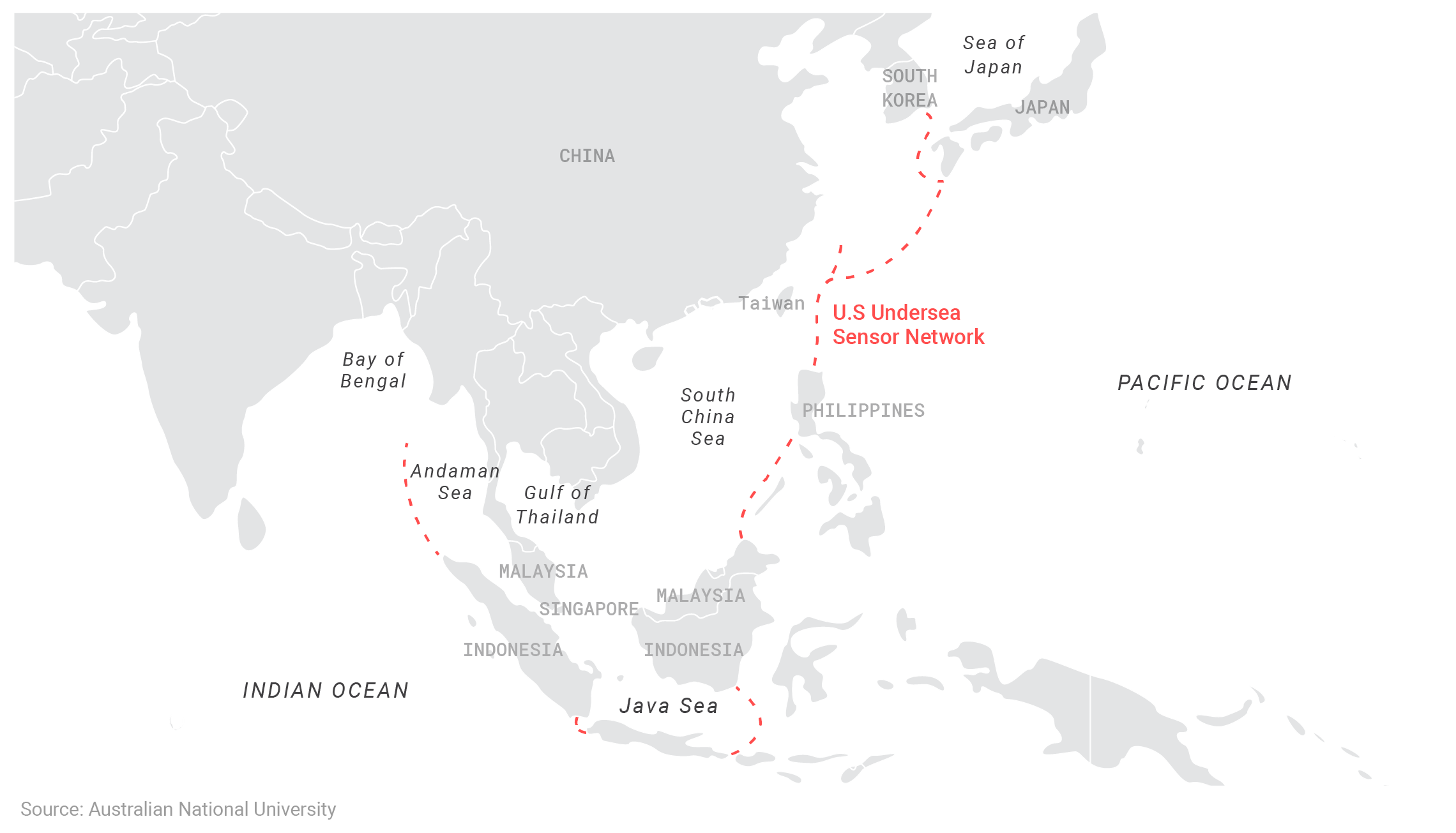
SOSUS can imperfectly be thought of as a kind of underwater radar. During the Cold War, the United States used it to track surface and undersea vessels in the Atlantic and Pacific, in some cases at great distances.45Cote, “Invisible Nuclear-Armed Submarines, or Transparent Oceans?” 32–34.
SOSUS relies on a unique oceanic phenomenon—the SOFAR or deep sound channel.46The acronym SOFAR derives from “Sound Fixing and Ranging” channel. Below a certain depth, sound in the ocean ceases to reflect to the surface and instead becomes trapped by pressure and temperature. This propagates the signal horizontally, potentially over thousands of miles. Placing hydrophones at the appropriate depth captures those signals. Access to the deep water of an ocean is required, usually off a continental shelf.47A detailed technical explanation of sound propagation properties in the ocean—to include the deep sound channel—can be found in Tom Stefanick, Strategic Antisubmarine Warfare and Naval Strategy (New York: Lexington Books, 1987), 227–240. For a shorter overview with visual depiction of the SOFAR, see “What is SOFAR?” National Ocean Service, National Oceanic and Atmospheric Administration, accessed January 28, 2022, https://oceanservice.noaa.gov/facts/sofar.html.
RAP is different. If SOSUS is roughly akin to radar, RAP is more like the motion detector in your neighbor’s yard: very sensitive, but extremely localized. SOSUS monitors whole swaths of ocean while RAP needs to be deployed at high-traffic chokepoints to be effective.48Cote, “Invisible Nuclear-Armed Submarines, or Transparent Oceans?” 33–34.
The second point to understand is that below a certain level of acoustic quieting, submarines stop registering on SOSUS. The United States was able to achieve this capability in the 1960s with its Permit-class nuclear attack submarines (SSNs) while the Soviet Union did so in the 1980s with its Akula-class SSNs.49Owen R. Cote, Jr., The Third Battle: Innovation in the U.S. Navy’s Silent Cold War Struggle with Soviet Submarines (Newport, RI: Naval War College Press, 2003), 26, 69–70. For reasons not clearly understood, China has been unable to devise the requisite quieting technology. Chinese submarines—to include its nuclear ballistic missile submarines (SSBNs)—are believed to have acoustic levels similar to their Soviet counterparts from the 1970s.50Chart, “Submarine Quieting Trends,” in Office of Naval Intelligence, “The People’s Liberation Army Navy: A Modern Navy with Chinese Characteristics,” August 2009, https://fas.org/irp/agency/oni/pla-navy.pdf. In short, they are not very good (quiet) by modern standards.
If China were to occupy Taiwan, it conceivably could sever the portion of the Fishhook covering the Miyako and Luzon Straits. This could remove the local monitoring provided by RAP in the waterways around Taiwan, but it would not eliminate SOSUS coverage in the Pacific as a whole. And it would not alter the fact that Chinese nuclear submarines remain substandard.
Until China can achieve super-quieting, its nuclear submarines will continue to register on acoustic sensors throughout the ocean. Alternately, if China does deploy super-quiet nuclear boats, they would render SOSUS moot, regardless of who controls Taiwan. In this case, technology trumps geography in importance.
Notional detectability of Chinese nuclear submarines

China lags behind other modern navies in terms of its nuclear undersea capabilities. It operates SSNs and SSBNs louder than Soviet/Russian designs first put to sea in the 1970s (Delta III) and 1980s (Akula).
In the specific case of SSBNs, it is also uncertain China will pursue long-range patrols in the open ocean. China is considered more likely to pursue a Soviet-style “bastion strategy” in the Asian littoral seas, whereby SSBNs remain close to home waters protected by surface ships and land-based aircraft.51For an overview of the potential costs and benefits to China of a bastion strategy versus open-ocean SSBN deployments, see Tong Zhao, Tides of Change: China’s Nuclear Ballistic Nuclear Submarines and Strategic Stability (Washington, DC: Carnegie Endowment for International Peace, 2018), 28–33, https://carnegietsinghua.org/2018/10/24/tides-of-changechina-s-nuclear-ballistic-missile-submarines-and-strategic-stability-pub-77490. DoD’s most recent report to Congress on the Chinese military echoes this assessment, identifying the South China Sea and Gulf of Bohai as possible bastion locations.52Office of the Secretary of Defense, “Annual Report to Congress,” 91.
Forward basing SSKs
Despite the deficiencies of its nuclear boats, China operates high-quality diesel-electric attack submarines (SSKs).53Lyle Goldstein, “The U.S.-China Naval Balance in the Asia-Pacific: An Overview,” China Quarterly 232 (December 2017): 916–917. With modern SSKs, quieting is usually very good when operating on battery power, but the trade-off is limited range. Here, forward basing on an occupied Taiwan—perhaps at the existing submarine base at Kaohsiung—would be useful. It could compensate for the range limitations of SSKs and allow them to stay on station longer in the eastern approaches to Taiwan or the chokepoints to the island’s north and south.
In general, diesel-electric submarines tend to be well suited to littoral environments, where they can wait for enemy vessels to come to them.54Owen R. Cote, Jr., “Assessing the Undersea Balance between the U.S. and China,” MIT Security Studies Program (SSP) Working Paper, February 2011, 8, https://www.usni.org/sites/default/files/inline-files/Undersea%20Balance%20WP11-1.pdf. In the open ocean, needing to actively seek out prey, range limitations become more problematic. Positioning Chinese SSKs in the high-traffic areas around Taiwan might mitigate this limitation, but most are unlikely to venture much farther into the Pacific.
An important exception might be China’s most advanced SSK, the Yuan-class. These are thought to be optimized for open-ocean operations and equipped with air-independent propulsion (AIP) systems, a technology that significantly enhances the submerged range of conventionally powered submarines.55Christopher P. Carlson, “Essay: Inside the Design of China’s Yuan-class Submarine,” U.S. Naval Institute News, August 31, 2015, https://news.usni.org/2015/08/31/essay-inside-the-design-of-chinas-yuan-class-submarine. Deployed from Taiwan, the Yuans could sortie deep into the Philippine Sea or possibly even north toward Japan’s east coast. However, the exact limits of their range when operating submerged on AIP is unclear from open sources. This makes it difficult to estimate precisely what the Yuans could threaten from Taiwan (e.g., Japanese ports).56It is necessary to distinguish between total range for an SSK and submerged range. For example, the Japanese Soryu-class SSK also operates an AIP system. It is reliably believed to have a range of 6,100 nautical miles. But this does not necessarily equate with the distance it can travel while submerged. Most SSKs can travel thousands of miles on the surface. While doing so, however, they are vulnerable to radar detection and are essentially defenseless. Submerged operations on battery power might be limited to a few hundred miles at best in the case of diesel-electric submarines without AIP. But precisely how much AIP extends submerged range remains uncertain from open sources. Soryu total range taken from Franz-Stefan Gady, “Japan Launches 10th Advanced High-Tech Attack Sub,” The Diplomat, November 9, 2017, https://thediplomat.com/2017/11/japan-launches-10th-advanced-high-tech-attack-sub/.
Regardless, Chinese occupation of Taiwan would increase the distance at which U.S. naval forces would need to begin considering the conventional submarine threat in the western Pacific. At the same time, China could base maritime patrol aircraft on Taiwan to conduct ASW patrols in the surrounding waters. This would complicate operations for U.S. submarines attempting to gain access to the Asian littoral through the Miyako and Luzon Straits. Collectively, the notion of occupied Taiwan as a defensive blocker would be reinforced, obstructing movement toward the Chinese coast and into the East and South China Seas. In this regard, there could be ancillary benefits for Chinese SSBNs if possessing Taiwan allows China to more effectively implement the aforementioned bastion strategy.
Accessing the SOFAR?
A 2021 analysis published by the Defense Threat Reduction Agency (DTRA) usefully pointed out that China would be able to tap into the SOFAR from occupied Taiwan, something it cannot currently do from the Asian littoral.57Green and Talmadge, “Then What? Assessing the Strategic Military Implications of Chinese Control of Taiwan,” 914. The DTRA report speculated that this could enable enhanced Chinese maritime surveillance in the Pacific. This prospect is worth further consideration as Taiwan’s military value continues to be weighed. But a key question is how much of the ocean China would be able to monitor using only sensors placed adjacent to Taiwan. The United States required thousands of miles of arrays to achieve good effects in the Atlantic and Pacific during the Cold War.58“Figure 17. Atlantic SOSUS Array Coverage, 1958–1978,” and “Figure 19. Pacific SOSUS Array Coverage, 1958–1978,” in John Stillion and Bryan Clark, What It Takes to Win: Succeeding in 21st Century Battle Network Competitions, (Washington, DC: Center for Strategic and Budgetary Assessments, 2015), 38, 41, https://csbaonline.org/research/publications/what-it-takes-to-win-succeeding-in-21st-century-battle-network-competitions.
The price of success
Overall, possessing Taiwan would improve China’s maritime geography and allow for a consolidation of control over the Asian littoral seas. Its value is likely to be greater in blunting offensive movement towards China rather than as a springboard for additional conquest in the Pacific. But there is no denying that control over Taiwan would enhance China’s strategic position. That said, those gains would be accompanied by two primary costs.
Latent balancing power and the regional reaction
The first of these is potential development of more robust defensive capabilities by regional states. In recent years, China has adopted an aggressive posture diplomatically and pursued low-level incursions in the Asian littoral, operations sometimes referred to as taking place “in the gray zone.”59U.S.-China Strategic Competition in South and East China Seas: Background and Issues for Congress, Congressional Research Service (R42784), updated January 18, 2022, https://sgp.fas.org/crs/row/R42784.pdf. Neither has had the effect of cowing regional states. To the contrary, most countries have opted for balancing approaches, rather than pursuing bandwagoning strategies to placate Beijing.60For the classic discussion of balancing and bandwagoning in international relations, see Stephen M. Walt, The Origins of Alliances (Ithaca, NY: Cornell University Press, 1987).
Perhaps most dramatically, Australia made a clear geopolitical choice to side with the United States long term. The AUKUS pact—which promises cooperation with the U.S. and United Kingdom on a range of advanced technologies, notably nuclear submarines—is the most high-profile representation of this.61“Joint Leaders Statement on AUKUS,” The White House, September 21, 2021, https://www.whitehouse.gov/briefing-room/statements-releases/2021/09/15/joint-leaders-statement-on-aukus/. But even before that agreement, Canberra moved to improve its long-range maritime strike options by purchasing the AGM-158C anti-ship missile and signing on to joint hypersonic research with the United States.62Malcolm Davis, “Australia Is Getting the Long-range Missiles Needed for a Contested Indo-Pacific,” The Strategist, Australian Strategic Policy Institute, July 2, 2020, https://www.aspistrategist.org.au/australia-is-getting-the-long-range-missiles-needed-for-a-contested-indo-pacific/; and Thomas Newdick, “Australia Teams Up with U.S. To Get Hypersonic Missiles for Its Super Hornets in Five Years,” The Drive, November 30, 2020, https://www.thedrive.com/the-war-zone/37875/australia-teams-up-with-u-s-to-get-hypersonic-missiles-for-its-super-hornets-in-five-years.
Meanwhile, Japan continues to debate its ability to contribute to a Taiwan crisis in support of the United States, a step that once would have been taboo.63Mirna Galic, “Japan’s Authorities in a Taiwan Contingency: Providing Needed Clarity,” War on the Rocks, October 6, 2021, https://warontherocks.com/2021/10/japans-authorities-in-a-taiwan-contingency-providing-needed-clarity/. Mated to this is a serious discussion among the ruling Liberal Democratic Party about possibly increasing the Japanese defense budget from 1 percent of GDP to the NATO goal of 2 percent.64Kosuke Takahashi, “Japan Approves Record Extra Defense Budget,” The Diplomat, November 26, 2021, https://thediplomat.com/2021/11/japan-approves-record-extra-defense-budget/. Already, its proposed 2023 defense budget is the largest in Japan’s post-war history.65Makiko Inoue and Ben Dooley, “Japan Approves Major Hike in Military Spending, With Taiwan in Mind,” New York Times, December 23, 2021, https://www.nytimes.com/2021/12/23/business/japan-defense-spending.html.
Elsewhere, the Philippines has quietly recommitted to routine exercises with U.S. forces.66Jim Gomez, “Philippine President Retains Pact Allowing U.S. War Exercises,” Los Angeles Times, July 30, 2021, https://www.latimes.com/world-nation/story/2021-07-30/philippine-president-retains-pact-allowing-u-s-war-exercises. And it is hard not to view Manila’s recent purchase of the BrahMos supersonic anti-ship cruise missile as an implicit statement of resolve against Chinese posturing.67Sebastian Stangio, “Philippines Confirms Purchase of BrahMos Supersonic Missile System,” The Diplomat, January 14, 2022, https://thediplomat.com/2022/01/philippines-confirms-purchase-of-brahmos-supersonic-missile-system/.
That is only a sampling of regional developments suggesting growing resistance to Beijing’s more muscular approach. As Patrick Porter and Michael Mazarr have noted, East Asia is a region rich in “untapped, latent balancing power.”68Patrick Porter and Michael Mazarr, “Countering China’s Adventurism over Taiwan: A Third Way,” The Lowy Institute, May 2021, https://www.lowyinstitute.org/publications/countering-china-s-adventurism-over-taiwan-third-way. This could be unlocked by an overt move against Taiwan, which would remove doubt about Chinese intentions.
Of course, it is possible that China executes a takeover of Taiwan with such speed and skill that it awes its neighbors into accommodation. This particularly could be the case if China were to rout the U.S. military in the process of capturing Taiwan.69Anand Toprani, Nicholas Murray, and Michael Dennis, “The Results of War Are Never Final: Meditations on an American Defeat,” RUSI Journal, January 24, 2022, https://doi.org/10.1080/03071847.2021.2022529. But this outcome is far from a certainty. Even if the United States withdrew from the region, Pacific states could opt for extreme measures in balancing China. Some Australian scholars, for example, have begun to openly discuss nuclear options as a hedge against a possible U.S. retreat from its alliance commitments.70Stephan Früling, “A Nuclear-Armed Australia: Contemplating the Unthinkable Option,” Australian Foreign Affairs 4 (October 2018), https://www.australianforeignaffairs.com/articles/extract/2018/10/a-nuclear-armed-australia; Patrick Porter, “Australia Needs a Bomb in the Basement,” Financial Review, April 9, 2021, https://www.afr.com/policy/foreign-affairs/australia-needs-a-bomb-in-the-basement-20210329-p57eya. A possible nuclear deterrent is also seeing increased interest in South Korea.71Michelle Ye Hee Lee, “South Koreans Overwhelmingly Want Nuclear Weapons to Confront China and North Korea, Poll Finds,” Washington Post, February 21, 2022, https://www.washingtonpost.com/world/2022/02/21/south-korea-nuclear-weapons/. It is difficult to conjure scenarios where an invasion of Taiwan results in a more hospitable regional environment for China.
The costs of occupation and garrisoning
As serious as that consequence would be for Beijing, it could pale compared to the ongoing expenditure of resources to placate and garrison Taiwan. Discussion of invasion scenarios sometimes treat the endeavor like a boardgame, one that ends when Chinese forces plant their flag on the main island. In truth, that moment will likely mark the start of a vicious land battle followed by an even more draining, open-ended occupation.72For an overview of what such operations might look like, see Easton, The Chinese Invasion Threat, 114–123.
It is worth recalling Taiwan’s size here. Although it is not massive, it is also not tiny. It is roughly one-and-a-half times the size of the U.S. state of New Hampshire or comparable to a small European country, like Denmark. This is not an inconsequential amount of land for an occupying army to cover. And three-quarters of Taiwan’s territory is mountainous, with much of the remaining ground covered by urban areas.73Easton, The Chinese Invasion Threat, 129.
It remains an open question as to how well the Taiwanese will fight—both its military and its civilian population.74For a detailed overview of Taiwan’s military defense planning, see Easton, The Chinese Invasion Threat, 175–211. On the prospects for civilian resistance in Taiwan, see Hunzeker and Lanoszka, A Question of Time, 105–114. Still, it is reasonable to assume that placating almost 24 million people would not be easy, especially if extreme violence and destruction are employed to bring them under Chinese dominion. Should even one quarter of one percent of the Taiwanese population take up arms post-invasion, that would be 60,000 partisans. Taiwan began to democratize in the 1980s; few people under 40 have any memory of living under full authoritarian rule. It may take intense measures—and extensive time—to subordinate them to the communist system. Maintaining basic order and security during that transition would consume massive resources and manpower. Added to that would be the actual cost of rebuilding Taiwanese infrastructure decimated in the act of conquest.
Sizing a Chinese occupation force
How many troops could a Chinese occupation require? As the United States became more involved in international peacekeeping in the 1990s, James Quinlivan, a mathematician with the RAND Corporation, examined previous stability missions. He found that most successful operations usually involved about 20 soldiers per 1,000 citizens, or a 1 to 50 ratio.75James T. Quinlivan, “Force Requirements in Stability Operations,” Parameters 25, no. 1 (Winter 1995): 59–69. This was the proportion British forces employed in both Malaya and Northern Ireland.76Quinlivan, “Force Requirements in Stability Operations.” It was roughly the same ratio used by NATO’s Implementation Force during the first five years of stability operations in Bosnia and Herzegovina.77James T. Quinlivan, “Burden of Victory: The Painful Arithmetic of Stability Operations,” RAND Review 27, no. 2 (Summer 2003): 28–29. In contrast, the best mark later achieved by U.S. forces in Iraq was approximately 1 to 170.78At the end of 2007, the U.S. deployed approximately 165,000 troops for an Iraqi population of about 28 million, or a ratio of roughly 1 to 170. U.S. force levels taken from “Table 3. U.S. Armed Forces and Contractor Personnel in Iraq,” in Department of Defense Contractor and Troop Levels in Afghanistan and Iraq: 2007–2018, Congressional Research Service (R44116), updated February 22, 2021, 13, https://fas.org/sgp/crs/natsec/R44116.pdf.
There are, of course, limits to the analytic value of such ratios, and the definition of successful operations can be debated (e.g., Northern Ireland). American, British, and NATO experiences are also far from an exact match for a Chinese occupation of Taiwan. But they nonetheless provide the best guide available for potential force commitments.
Using the ideal of a 1 to 50 ratio, the People’s Liberation Army (PLA) would need to commit a staggering 480,000 troops to Taiwan in a post-invasion scenario. (The PLA has a current active end strength of about 2 million.)79“Chapter Six: Asia,” The Military Balance, 249. Even at a ratio of 1 to 100, the requirement approaches 250,000 troops. Granted, other instruments of the Chinese security apparatus—notably the paramilitary People’s Armed Police (PAP)—could alleviate some of this burden. But the PAP’s resources are not infinite either, with an estimated active end strength of about 500,000.80“Chapter Six: Asia,” The Military Balance, 257. And both the PLA and the PAP ultimately draw on the same resource base. Chinese state coffers and its pool of qualified manpower would be stressed regardless of which entity takes the lead in the occupation of Taiwan.
Moreover, force requirements are not confined simply to troops in the field. Quinlivan also showed that for every soldier deployed, several more need to be in train. For example, if a military wanted to confine tours in-country to six months and not rotate the same soldiers into a stability operation more than once every two years, five soldiers are needed for every one deployed at a given time.81Quinlivan, “Burden of Victory,” 29.
Thus, an occupation force of 240,000 (or a 1 to 100 ratio) for Taiwan might necessitate a total force commitment of more than 1 million to sustain necessary troop levels on the island over multiple years. China could cut this number by prolonging tours and rotating troops back onto Taiwan at a quicker pace. But this could deteriorate performance in what already is likely to be difficult, demoralizing work.
In the end, China should be able to meet the force requirements needed to subjugate Taiwan, but the toll could limit Beijing’s ability to take significant action elsewhere. This reiterates the idea of Taiwan as static territory, not a dynamic conduit for additional conquest.
Notional Chinese occupation force
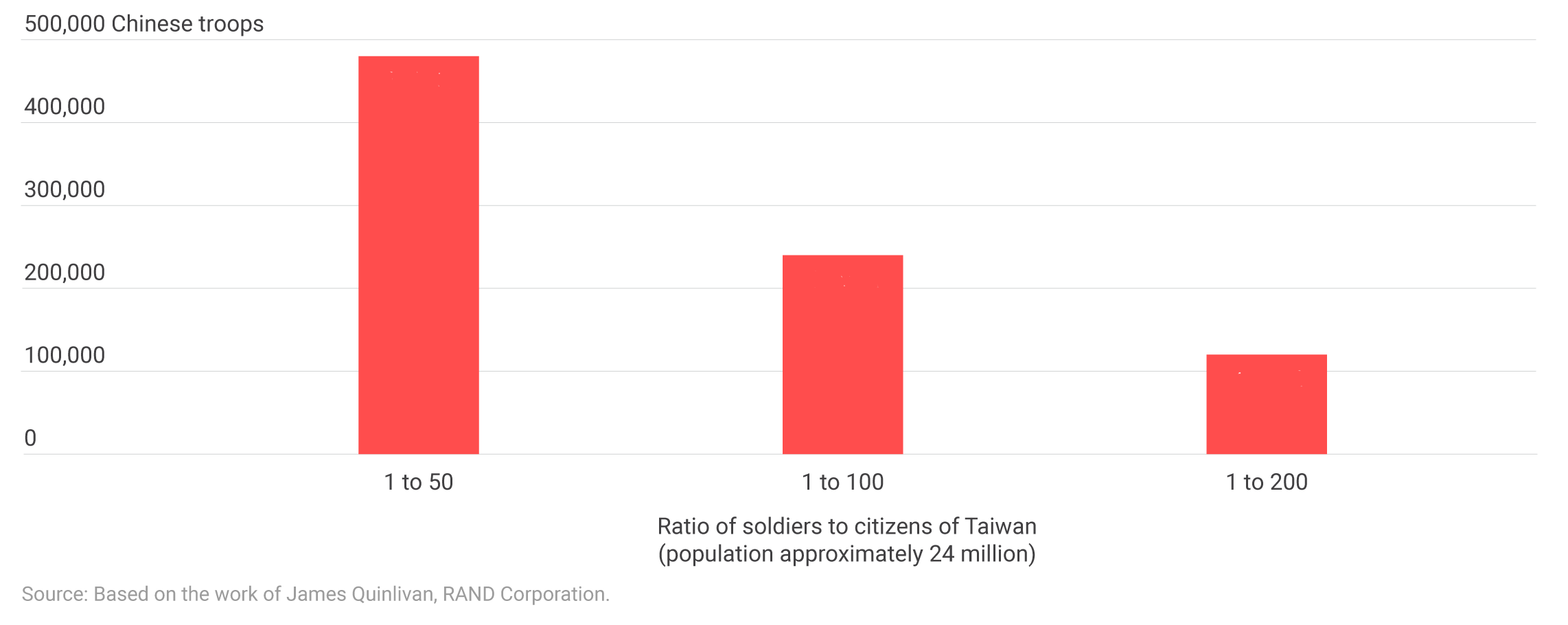
Assessing Taiwan’s military utility
While Chinese military planners certainly would exploit an occupation of Taiwan to their best advantage, in truth, its military utility is not the primary motivation for invasion. Rather Taiwan’s political and historical relevance to the leadership of the Chinese Communist Party (CCP) and the personal stake President Xi Jinping has placed in reunification are far more potent factors.82Avery Goldstein, “China’s Grand Strategy Under Xi Jinping,” International Security 45, no. 1 (Summer 2020): 191–193. The arguments discussed in this paper are, frankly, likely to have more relevance to U.S. debates about the merits of defending the island, as alluded to in the introduction.
From that perspective, Taiwan is a mixed bag. An aggregate assessment of its military utility will come down to the variance in the negative variables—the intensity of the regional reaction and the actual costs of garrisoning the island. The positive effects are easier to estimate. At a minimum, controlling Taiwan will expand the effective range of the Chinese A2/AD bubble against surface ships. It would also solidify the South China Sea’s status as a Chinese “lake” and substantially tighten Beijing’s hold over the East China Sea as well. These will be important gains for China, although neither in itself warrants the potential risks of an invasion and possible war with the United States. Still, if the negative consequences of occupation do not manifest in the extreme, it may be that Taiwan represents a net positive for the Chinese military.
However, given the uncertainty surrounding a number of elements—including the veracity of long-term resistance and the nature of the response from neighboring states—it is also easy to sketch outcomes where the price of occupying Taiwan easily outweighs the benefit for China. When one factors in the costs Beijing already faces in actively suborning large portions of its territory—including Hong Kong, Tibet, and Xinjiang—an occupation of Taiwan could represent a dangerous additional drain on resources. This posits a one-way gamble for China; once it expends the blood and treasure to take Taiwan, it will be next to impossible for President Xi and the CCP to simply withdraw, no matter what price is being exacted.
Unaddressed in this analysis is the toll the invasion itself would take on the Chinese military. Outcomes for Taiwan conflict scenarios can vary widely—depending in part on the degree of involvement by the United States and its allies. It is instructive to recall that U.S. military planners —even amidst the carnage of World War II—ultimately felt the cost of invading Formosa could be too much. How much China sacrifices to gain Taiwan is a separate discussion but one that should eventually be factored into an aggregate assessment of Taiwan’s military utility.
Endnotes
- 1See, for example, Charles L. Glaser, “Washington Is Avoiding the Tough Questions on Taiwan and China,” Foreign Affairs, April 28, 2021, https://www.foreignaffairs.com/articles/asia/2021-04-28/washington-avoiding-tough-questions-taiwan-and-china, and Blake Herzinger, “Abandoning Taiwan Makes Zero Moral or Strategic Sense,” Foreign Policy, May 3, 2021, https://foreignpolicy.com/2021/05/03/taiwan-policy-us-china-abandon/.
- 2For another effort in this vein, see Brendan Rittenhouse Green and Caitlin Talmadge, “Then What? Assessing the Strategic Military Implications of Chinese Control of Taiwan,” Defense Threat Reduction Agency, May 2021.
- 3For an extended discussion of the geographic features and strategic importance of Matsu, Kinmen, and Penghu, see Ian Easton, The Chinese Invasion Threat (Manchester, UK: Eastbridge Books, 2019), 97–103.
- 4This is not to imply that a Chinese invasion of Taiwan would play out in similar fashion to Operation Overlord. Congruence in the distance across the English Channel and the Taiwan Strait is largely where the comparison ends. See Ian Easton, “Why a Taiwan Invasion Would Look Nothing Like D-Day,” The Diplomat, May 26, 2021, https://thediplomat.com/2021/05/why-a-taiwan-invasion-would-look-nothing-like-d-day/.
- 5See, for example, the comments by Randall Schriver in Helen Davidson, “Chinese Flyovers Towards Taiwan Peaked in October amid Rising Tensions,” The Guardian, November 2, 2020, https://www.theguardian.com/world/2020/nov/02/chinese-flyovers-towards-taiwan-peaked-in-october-amid-rising-tensions.
- 6See, for example, Thomas Shugart’s Twitter post as referenced in Herzinger, “Abandoning Taiwan Makes Zero Moral or Strategic Sense.”
- 7For a more fulsome discussion of the debate among U.S. military commanders over “Formosa vs. Luzon,” see Robert Ross Smith, Triumph in the Philippines (1993; repr., Washington, DC: United States Army, 1963), 3–17.
- 8Smith, Triumph in the Philippines, 3–4.
- 9Smith, Triumph in the Philippines, 11–13.
- 10Angelo N. Caravaggio, “Winning’ the Pacific War: The Masterful Strategy of Commander Minoru Genda,” Naval War College Review 67, no. 1 (Winter 2014): 85–118.
- 11Kenneth P. Werrell, The Evolution of the Cruise Missile, (Maxwell AFB, AL: Air University Press, 1985), 41–78.
- 12Toshi Yoshihara and James R. Holmes, Red Star Over the Pacific (Annapolis, MD: Naval Institute Press, 2018), 221–227.
- 13In part, this is one reason Taiwan itself has been encouraged to invest in shore-based anti-ship cruise missiles as part of a broader asymmetric defensive strategy, a path Taipei has been reluctant to pursue. See Michael A. Hunzeker, “Taiwan’s Defense Plans Are Going Off the Rails,” War on the Rocks, November 18, 2021, https://warontherocks.com/2021/11/taiwans-defense-plans-are-going-off-the-rails/.
- 14For a historical overview of “the stopping power of water,” see John J. Mearsheimer, The Tragedy of Great Power Politics, updated ed. (New York: W.W. Norton & Company, 2014), 114–128. See also the discussion of the challenges of amphibious invasion in Elbridge Colby, The Strategy of Denial: American Defense in an Age of Great Power Conflict (New Haven, CT: Yale University Press, 2021), 155–159.
- 15Smith, Triumph in the Philippines, 18–19.
- 16Northern Luzon is dominated by mountains—the Cordillera range in the west and the Sierra Madre in the east. In between lies the close confines of the Cagayan Valley, which narrows as it proceeds south. The valley’s southern end, in turn, is blocked by a third range, the Caraballo Mountains.
- 17Thomas Shugart (@tshugart3), Twitter post, April 30, 2021, https://twitter.com/tshugart3/status/1388214889424982019.
- 18Office of the Secretary of Defense, “Annual Report to Congress: Military and Security Developments Involving the People’s Republic of China” (Washington, DC: Government Printing Office, 2021), 49–50, https://www.defense.gov/News/Releases/Release/Article/2831819/dod-releases-2021-report-on-military-and-security-developments-involving-the-pe/.
- 19For an in-depth discussion of this topic, see John Speed Meyers, Mainland Strikes and U.S. Military Strategy Towards China: Historical Cases, Interviews, and a Scenario-Based Survey of American National Security Elites (Santa Monica, CA: RAND Corporation, 2019), https://www.rand.org/pubs/rgs_dissertations/RGSD430.html.
- 20A test in August of 2020 appeared to demonstrate China’s ability to strike a moving ship in the South China Sea, with both a DF-21 and a DF-26 reportedly hitting an underway vessel in rapid succession. The test likely assuaged any lingering doubts regarding the DF-26’s accuracy, but it did not necessarily validate the ability of Chinese sensors to detect and cue missile systems because the parameters of the test are unknown (i.e., whether the ship’s position and heading were identified beforehand or if it was independently detected by cuing sensors). See Steve Stashwick, “Chinese Ballistic Missiles Fired Into South China Sea Claimed to Hit Target Ship,” The Diplomat, November 17, 2020, https://thediplomat.com/2020/11/chinese-ballistic-missiles-fired-into-south-china-sea-claimed-to-hit-target-ship/; and Joseph Trevithick, “Chinese Long-Range Ballistic Missiles Struck Moving Ship In South China Sea: Report,” The Drive, November 16, 2020, https://www.thedrive.com/the-war-zone/37662/chinese-long-range-ballistic-missiles-struck-moving-ship-in-south-china-sea-report.
- 21Hans M. Kristensen, “China’s Strategic Systems and Programs” in James M. Smith and Paul J. Bolt, eds., China’s Strategic Arsenal: Worldview, Doctrine, and Systems (Washington, DC: Georgetown University Press, 2021), 116.
- 22Felix K. Chang, “China’s Maritime Intelligence, Surveillance, and Reconnaissance Capability in the South China Sea,” Foreign Policy Research Institute, May 5, 2021, https://www.fpri.org/article/2021/05/chinas-maritime-intelligence-surveillance-and-reconnaissance-capability-in-the-south-china-sea/.
- 23Kristensen, “China’s Strategic Systems and Programs,” 117; and Andrew Jones, “China Launches Trio of Yaogan-31 Ocean Reconnaissance Satellites,” Space News, February 24, 2021, https://spacenews.com/china-launches-trio-of-yaogan-31-ocean-reconnaissance-satellites/.
- 24For example, one close study of the issue suggests that the Yaogan constellation could provide the location of a U.S. aircraft carrier in the Pacific to within less than 10 km. This is an impressive technological feat and consistent with the claim that China can reliably track U.S. battlegroups in the Pacific. However, 10 km still represents too wide a variance for accurate targeting of missiles fired from hundreds, if not thousands, of miles away. See S. Chandrashekar and Soma Perumal, “China’s Constellation of Yaogan Satellites & the Anti-Ship Ballistic Missile: May 2016 Update,” International Strategic and Security Studies Programme, National Institute of Advanced Studies, May 2016, http://isssp.in/wp-content/uploads/2016/05/Yaogan-and-ASBM-May-2016-Report.pdf.
- 25Andrew Jones, “China Launches New Group of Classified Yaogan-30 Satellites,” Space News, June 18, 2021, https://spacenews.com/china-launches-new-group-of-classified-yaogan-30-satellites/.
- 26For an extended discussion of the sensor limitations of Chinese A2/AD, see Steven Biddle and Ivan Oelrich, “Future Warfare in the Western Pacific,” International Security 41, no. 1 (Spring 2016): 7–48.
- 27Biddle and Oelrich speculate that this limit could be extended to about 600 km total from the Chinese shoreline, if the aircraft were to operate off the coast but still within the protective bubble of Chinese air defenses. This could push the effective radar coverage to approximately 370 miles into the adjoining sea. See Biddle and Oelrich, “Future Warfare in the Western Pacific,” 13.
- 28“Chapter Six: Asia,” The Military Balance, February 24, 2021, 218–313, https://doi.org/10.1080/04597222.2021.1868795.
- 29Chang, “China’s Maritime Intelligence, Surveillance, and Reconnaissance Capability in the South China Sea.”
- 30For a discussion of the impediments posed to Chinese air forces by Taiwan’s existing air defenses, see Green and Talmadge, “Then What? Assessing the Strategic Military Implications of Chinese Control of Taiwan,” 6–8.
- 31Smith, Triumph in the Philippines, 3–4.
- 32James R. Holmes, “Strategic Features of the South China Sea: A Tough Neighborhood for Hegemons,” Naval War College Review 67, no. 2 (Spring 2014): 47.
- 33Michael A. Hunzeker and Alexander Lanoszka, with Brian Davis, Matthew Fay, Erik Goepner, Joseph Petrucelli, and Erica Seng-White, A Question of Time: Enhancing Taiwan’s Conventional Deterrence Posture (Arlington, VA: Center for Security Policy Studies, 2018), 52–53, https://csps.gmu.edu/wp-content/uploads/2018/11/A-Question-of-Time.pdf.
- 34In 2016, 47 percent of South Korea’s total trade passed through the South China Sea as compared to 19 percent for Japan. “Putting a Price on the South China Sea: Percentage of All Trade,” in “How Much Trade Transits the South China Sea?” Center for Strategic and International Studies, China Power, accessed February 11, 2022, https://chinapower.csis.org/much-trade-transits-south-china-sea/.
- 35For example, the brief, six-day “quarantine” of Cuba during the 1962 missile crisis required 46 ships, 240 aircraft, and 30,000 personnel to implement. Dan E. Caldwell, “A Research Note on the Quarantine of Cuba October 1962,” International Studies Quarterly 22, no. 4 (December 1978): 629.
- 36Fiona S. Cunningham, “The Maritime Rung on the Escalation Ladder: Naval Blockades in a U.S.-China Conflict,” Security Studies 29, no. 4 (2020): 730–768, https://doi.org/10.1080/09636412.2020.1811462.
- 37Cunningham, “The Maritime Rung on the Escalation Ladder,” 758–760.
- 38China has a fleet of approximately 350 battle force ships as compared to 293 for the U.S. Navy. Ronald O’Rourke, China Naval Modernization: Implications for U.S. Navy Capabilities—Background and Issues for Congress, Congressional Research Service (RL33153), updated October 28, 2021, 28–31, https://sgp.fas.org/crs/row/RL33153.pdf.
- 39Kerem Coşar and Benjamin D. Thomas, “The Geopolitics of Trade in Southeast Asia,” NBER Working Paper 28048, National Bureau of Economic Research, November 2020, https://www.nber.org/papers/w28048.
- 40“Table 2: Predicted Welfare Losses for Countries in the Region,” in Coşar and Thomas, “The Geopolitics of Trade in Southeast Asia,” 11.
- 41Eugene Gholz and Daryl Pressman, “Protecting ‘The Prize’: Oil and U.S. National Interest,” Security Studies 19, no. 3 (2010): 462–463, https://doi.org/10.1080/09636412.2010.505865.
- 42For example, the impact of occupying Taiwan on Chinese submarine operations figures prominently in both Glaser, “Washington Is Avoiding the Tough Questions on Taiwan and China,” and Herzinger, “Abandoning Taiwan Makes Zero Moral or Strategic Sense.”
- 43Desmond Ball and Richard Tanter, The Tools of Owatatsumi: Japan’s Ocean Surveillance and Coastal Defence Capabilities (Canberra, AU: Australian National University Press, 2015), 51–54.
- 44For more on the specific properties of SOSUS and RAP, see Owen R. Cote, Jr., “Invisible Nuclear-Armed Submarines, or Transparent Oceans? Are Ballistic Missile Submarines Still the Best Deterrent for the United States?” Bulletin of the Atomic Scientists 75, no. 1 (2019): 32–34, https://doi.org/10.1080/00963402.2019.1555998.
- 45Cote, “Invisible Nuclear-Armed Submarines, or Transparent Oceans?” 32–34.
- 46The acronym SOFAR derives from “Sound Fixing and Ranging” channel.
- 47A detailed technical explanation of sound propagation properties in the ocean—to include the deep sound channel—can be found in Tom Stefanick, Strategic Antisubmarine Warfare and Naval Strategy (New York: Lexington Books, 1987), 227–240. For a shorter overview with visual depiction of the SOFAR, see “What is SOFAR?” National Ocean Service, National Oceanic and Atmospheric Administration, accessed January 28, 2022, https://oceanservice.noaa.gov/facts/sofar.html.
- 48Cote, “Invisible Nuclear-Armed Submarines, or Transparent Oceans?” 33–34.
- 49Owen R. Cote, Jr., The Third Battle: Innovation in the U.S. Navy’s Silent Cold War Struggle with Soviet Submarines (Newport, RI: Naval War College Press, 2003), 26, 69–70.
- 50Chart, “Submarine Quieting Trends,” in Office of Naval Intelligence, “The People’s Liberation Army Navy: A Modern Navy with Chinese Characteristics,” August 2009, https://fas.org/irp/agency/oni/pla-navy.pdf.
- 51For an overview of the potential costs and benefits to China of a bastion strategy versus open-ocean SSBN deployments, see Tong Zhao, Tides of Change: China’s Nuclear Ballistic Nuclear Submarines and Strategic Stability (Washington, DC: Carnegie Endowment for International Peace, 2018), 28–33, https://carnegietsinghua.org/2018/10/24/tides-of-changechina-s-nuclear-ballistic-missile-submarines-and-strategic-stability-pub-77490.
- 52Office of the Secretary of Defense, “Annual Report to Congress,” 91.
- 53Lyle Goldstein, “The U.S.-China Naval Balance in the Asia-Pacific: An Overview,” China Quarterly 232 (December 2017): 916–917.
- 54Owen R. Cote, Jr., “Assessing the Undersea Balance between the U.S. and China,” MIT Security Studies Program (SSP) Working Paper, February 2011, 8, https://www.usni.org/sites/default/files/inline-files/Undersea%20Balance%20WP11-1.pdf.
- 55Christopher P. Carlson, “Essay: Inside the Design of China’s Yuan-class Submarine,” U.S. Naval Institute News, August 31, 2015, https://news.usni.org/2015/08/31/essay-inside-the-design-of-chinas-yuan-class-submarine.
- 56It is necessary to distinguish between total range for an SSK and submerged range. For example, the Japanese Soryu-class SSK also operates an AIP system. It is reliably believed to have a range of 6,100 nautical miles. But this does not necessarily equate with the distance it can travel while submerged. Most SSKs can travel thousands of miles on the surface. While doing so, however, they are vulnerable to radar detection and are essentially defenseless. Submerged operations on battery power might be limited to a few hundred miles at best in the case of diesel-electric submarines without AIP. But precisely how much AIP extends submerged range remains uncertain from open sources. Soryu total range taken from Franz-Stefan Gady, “Japan Launches 10th Advanced High-Tech Attack Sub,” The Diplomat, November 9, 2017, https://thediplomat.com/2017/11/japan-launches-10th-advanced-high-tech-attack-sub/.
- 57Green and Talmadge, “Then What? Assessing the Strategic Military Implications of Chinese Control of Taiwan,” 914.
- 58“Figure 17. Atlantic SOSUS Array Coverage, 1958–1978,” and “Figure 19. Pacific SOSUS Array Coverage, 1958–1978,” in John Stillion and Bryan Clark, What It Takes to Win: Succeeding in 21st Century Battle Network Competitions, (Washington, DC: Center for Strategic and Budgetary Assessments, 2015), 38, 41, https://csbaonline.org/research/publications/what-it-takes-to-win-succeeding-in-21st-century-battle-network-competitions.
- 59U.S.-China Strategic Competition in South and East China Seas: Background and Issues for Congress, Congressional Research Service (R42784), updated January 18, 2022, https://sgp.fas.org/crs/row/R42784.pdf.
- 60For the classic discussion of balancing and bandwagoning in international relations, see Stephen M. Walt, The Origins of Alliances (Ithaca, NY: Cornell University Press, 1987).
- 61“Joint Leaders Statement on AUKUS,” The White House, September 21, 2021, https://www.whitehouse.gov/briefing-room/statements-releases/2021/09/15/joint-leaders-statement-on-aukus/.
- 62Malcolm Davis, “Australia Is Getting the Long-range Missiles Needed for a Contested Indo-Pacific,” The Strategist, Australian Strategic Policy Institute, July 2, 2020, https://www.aspistrategist.org.au/australia-is-getting-the-long-range-missiles-needed-for-a-contested-indo-pacific/; and Thomas Newdick, “Australia Teams Up with U.S. To Get Hypersonic Missiles for Its Super Hornets in Five Years,” The Drive, November 30, 2020, https://www.thedrive.com/the-war-zone/37875/australia-teams-up-with-u-s-to-get-hypersonic-missiles-for-its-super-hornets-in-five-years.
- 63Mirna Galic, “Japan’s Authorities in a Taiwan Contingency: Providing Needed Clarity,” War on the Rocks, October 6, 2021, https://warontherocks.com/2021/10/japans-authorities-in-a-taiwan-contingency-providing-needed-clarity/.
- 64Kosuke Takahashi, “Japan Approves Record Extra Defense Budget,” The Diplomat, November 26, 2021, https://thediplomat.com/2021/11/japan-approves-record-extra-defense-budget/.
- 65Makiko Inoue and Ben Dooley, “Japan Approves Major Hike in Military Spending, With Taiwan in Mind,” New York Times, December 23, 2021, https://www.nytimes.com/2021/12/23/business/japan-defense-spending.html.
- 66Jim Gomez, “Philippine President Retains Pact Allowing U.S. War Exercises,” Los Angeles Times, July 30, 2021, https://www.latimes.com/world-nation/story/2021-07-30/philippine-president-retains-pact-allowing-u-s-war-exercises.
- 67Sebastian Stangio, “Philippines Confirms Purchase of BrahMos Supersonic Missile System,” The Diplomat, January 14, 2022, https://thediplomat.com/2022/01/philippines-confirms-purchase-of-brahmos-supersonic-missile-system/.
- 68Patrick Porter and Michael Mazarr, “Countering China’s Adventurism over Taiwan: A Third Way,” The Lowy Institute, May 2021, https://www.lowyinstitute.org/publications/countering-china-s-adventurism-over-taiwan-third-way.
- 69Anand Toprani, Nicholas Murray, and Michael Dennis, “The Results of War Are Never Final: Meditations on an American Defeat,” RUSI Journal, January 24, 2022, https://doi.org/10.1080/03071847.2021.2022529.
- 70Stephan Früling, “A Nuclear-Armed Australia: Contemplating the Unthinkable Option,” Australian Foreign Affairs 4 (October 2018), https://www.australianforeignaffairs.com/articles/extract/2018/10/a-nuclear-armed-australia; Patrick Porter, “Australia Needs a Bomb in the Basement,” Financial Review, April 9, 2021, https://www.afr.com/policy/foreign-affairs/australia-needs-a-bomb-in-the-basement-20210329-p57eya.
- 71Michelle Ye Hee Lee, “South Koreans Overwhelmingly Want Nuclear Weapons to Confront China and North Korea, Poll Finds,” Washington Post, February 21, 2022, https://www.washingtonpost.com/world/2022/02/21/south-korea-nuclear-weapons/.
- 72For an overview of what such operations might look like, see Easton, The Chinese Invasion Threat, 114–123.
- 73Easton, The Chinese Invasion Threat, 129.
- 74For a detailed overview of Taiwan’s military defense planning, see Easton, The Chinese Invasion Threat, 175–211. On the prospects for civilian resistance in Taiwan, see Hunzeker and Lanoszka, A Question of Time, 105–114.
- 75James T. Quinlivan, “Force Requirements in Stability Operations,” Parameters 25, no. 1 (Winter 1995): 59–69.
- 76Quinlivan, “Force Requirements in Stability Operations.”
- 77James T. Quinlivan, “Burden of Victory: The Painful Arithmetic of Stability Operations,” RAND Review 27, no. 2 (Summer 2003): 28–29.
- 78At the end of 2007, the U.S. deployed approximately 165,000 troops for an Iraqi population of about 28 million, or a ratio of roughly 1 to 170. U.S. force levels taken from “Table 3. U.S. Armed Forces and Contractor Personnel in Iraq,” in Department of Defense Contractor and Troop Levels in Afghanistan and Iraq: 2007–2018, Congressional Research Service (R44116), updated February 22, 2021, 13, https://fas.org/sgp/crs/natsec/R44116.pdf.
- 79“Chapter Six: Asia,” The Military Balance, 249.
- 80“Chapter Six: Asia,” The Military Balance, 257.
- 81Quinlivan, “Burden of Victory,” 29.
- 82Avery Goldstein, “China’s Grand Strategy Under Xi Jinping,” International Security 45, no. 1 (Summer 2020): 191–193.
More on Asia
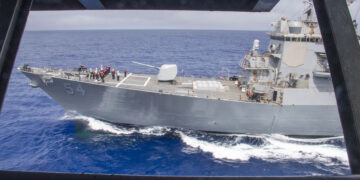
By John Mueller
April 10, 2025
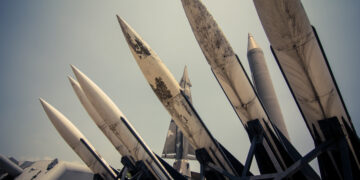
Featuring Jennifer Kavanagh
April 2, 2025

